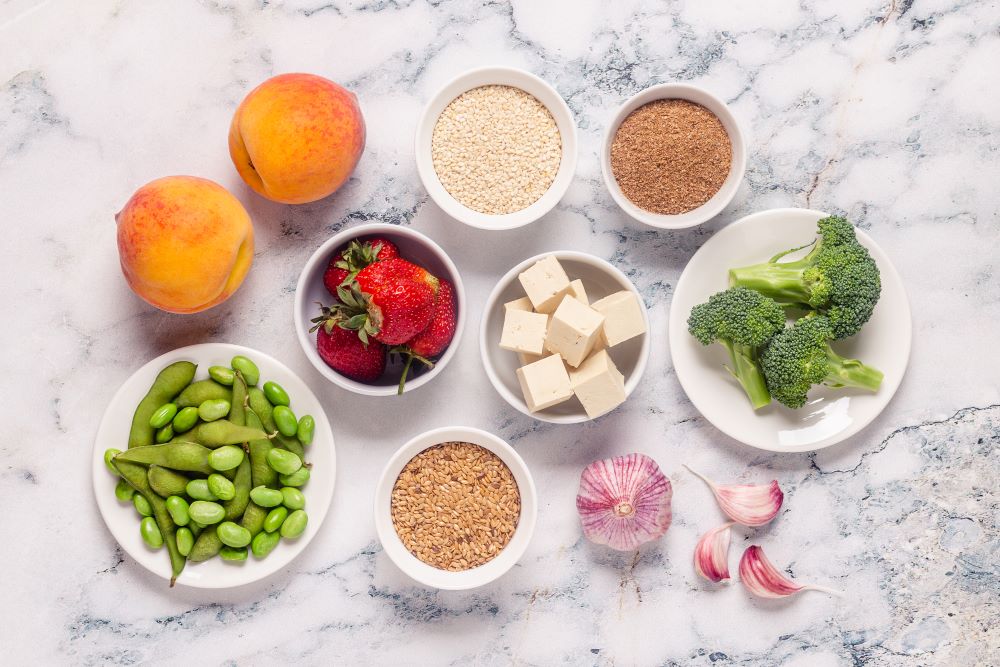Perimenopause is the period of time leading up to menopause, during which a woman's body makes the natural transition toward permanent infertility. Hormone levels, especially estrogen, fluctuate greatly during this time, which can lead to various symptoms such as hot flashes, night sweats, mood swings, and changes in menstrual cycle.
Diet can play a significant role in managing these symptoms. The Perimenopause Diet isn't a diet to lose weight, but a diet that incorporates the foods that can ease the symptoms of Menopause.
.png)
Which Foods to Include in Your Regular Diet:
Eat a balanced diet that includes plenty of fruits and vegetables, whole grains, lean proteins, and healthy fats. These foods can provide the nutrients you need, help maintain a healthy weight, and reduce the risk of heart disease and osteoporosis, both of which increase after menopause.
Calcium and Vitamin D:
Bone loss accelerates during perimenopause due to decreased estrogen levels. Foods high in calcium and vitamin D can help maintain bone health. These include dairy products, fortified cereals and juices, dark green leafy vegetables, and fish with bones.
If you can't get enough from your diet, supplements might be beneficial.
More Reading: The 5 Best Calcium Supplements to Include in Your Diet

Phytoestrogens:
Phytoestrogens are plant-based compounds that act like a weak form of estrogen in the body and may help balance your hormones. Foods high in phytoestrogens include soybeans and soy products, flaxseeds, nuts, whole grains, and certain fruits and vegetables.
Water:
Drink plenty of water to help combat the dry skin and dryness of mucous membranes (such as in the mouth and vagina) associated with perimenopause. Hydration can also help manage weight and support overall health.
Avoid Triggers:
Some women find that certain foods and drinks trigger their hot flashes, night sweats, or mood swings. Common triggers include alcohol, caffeine, and foods with a high sugar or spice content.
Limit Processed Foods:
Processed foods can be high in salt, sugar, and unhealthy fats. Try to limit your intake of these types of foods and instead focus on eating whole foods.
Regular Exercise:
While not a dietary recommendation, regular physical activity combined with a balanced diet can help manage weight gain, improve mood, promote better sleep, and strengthen your bones.
It's important to note that dietary needs can vary greatly from person to person. Always consult a healthcare provider or a nutritionist for personalized advice. And remember, a healthy lifestyle isn't just about diet, but also includes regular exercise, getting enough sleep, managing stress, and avoiding harmful habits like smoking.

Is the Perimenopause Diet Right for You?
The Perimenopause Diet is all about healthy eating and getting the right nutrients for your body - nutrients that support and ease the symptoms of menopause.
So no matter who you are, or what stage of life you are in, the Perimenopause Diet can be a great way of eating well.
If you are watching your weight, take into account your portion controls.
Perimenopause Meal Plans:
Creating a meal plan during perimenopause can be a great way to ensure that you're getting all the necessary nutrients to help manage symptoms and support your overall health. Here are simple one-day meal plan suggestions. Chop and change to find one that suits your taste.
Remember that everyone's needs and preferences are different, and this is just an example:
Day 1: Perimenopause Diet Meal Plan
Breakfast:
- A bowl of fortified whole grain cereal with almond milk (fortified with calcium) and a sprinkle of flax seeds.
- A glass of freshly squeezed orange juice for additional calcium and vitamin C.
- A cup of green tea (avoiding caffeine if it triggers your symptoms).
Mid-Morning Snack:
- A small handful of almonds or a couple of dried figs, both of which are good sources of calcium.
Lunch:
- A leafy green salad with spinach and kale, grilled salmon (if you like fish), cherry tomatoes, cucumber, and a vinaigrette dressing.
- Whole grain bread on the side for added fiber.
Afternoon Snack:
- Greek yogurt topped with chia seeds and fresh berries.
Dinner:
- A serving of grilled tofu with a stir-fry of bok choy, broccoli, bell peppers, and other veggies of your choice.
- Serve this with brown rice or quinoa for additional nutrients and fiber.
Evening Snack:
- A piece of fresh fruit like a banana or apple.
Ensure to hydrate adequately throughout the day. Drinking water before meals can also help control appetite and prevent overeating.

Day 2: Perimenopause Diet Meal Plan
Breakfast:
- Scrambled eggs with spinach and feta cheese.
- A slice of whole-grain toast.
- A glass of fortified orange juice (rich in vitamin D and calcium).
Morning Snack:
- A handful of almonds (good source of calcium and healthy fats).
Lunch:
- Grilled salmon salad (salmon for omega-3 fatty acids, greens for calcium).
- Whole grain bread roll.
- A glass of fortified soymilk (for phytoestrogens and additional calcium).
Afternoon Snack:
- Greek yogurt with a drizzle of honey and a sprinkle of chia seeds (calcium and healthy fats).
Dinner:
- Stir-fried tofu with broccoli, bok choy, capsicums, and a soy sauce (tofu and greens for calcium, capsicum for vitamin C to help with iron absorption).
- Brown rice on the side (for extra fibre).
Evening Snack:
- A fig and almond snack bar or a piece of fruit.
Beverages:
- Drink water throughout the day for hydration.
- Limit caffeine and alcohol as these can trigger hot flashes in some women.

Day 3: Perimenopause Diet Meal Plan
Breakfast
- Overnight oats made with a cup of rolled oats, almond milk (calcium-fortified), a tablespoon of chia seeds (high in omega-3 fatty acids), a sprinkle of cinnamon, and topped with mixed berries (rich in antioxidants).
Mid-Morning Snack
- A handful of almonds (providing healthy fats, fibre, and calcium) and an orange (for a dose of vitamin C and additional calcium).
Lunch
- Quinoa salad with mixed vegetables (like spinach, kale, capsicums), black beans (protein and fibre), cherry tomatoes, cucumber, and feta cheese, dressed with olive oil and lemon vinaigrette.
Afternoon Snack
- Greek yogurt (high in protein and calcium) with a drizzle of honey and a small handful of low fat muesli for crunch.
Dinner
- Grilled salmon (rich in omega-3 fatty acids) with a side of roasted sweet potatoes (providing vitamin A and fibre) and steamed broccoli (for a boost of calcium and fibre).
Evening Snack
- A small bowl of fresh fruit or a piece of dark chocolate (rich in antioxidants).

Day 4: Perimenopause Diet Meal Plan
Breakfast:
- Two slices of whole grain toast with avocado and two boiled eggs. Add a sprinkle of sesame seeds for extra calcium.
Lunch:
- A bowl of lentil soup with a side salad (mixed greens, cherry tomatoes, cucumber, with a vinaigrette dressing).
Snack:
- Greek yogurt with a drizzle of honey and a small handful of walnuts.
Dinner:
- Baked chicken breast served with sweet potatoes and sautéed kale.

Day 5: Perimenopause Diet Meal Plan
Breakfast:
- A smoothie made with fortified almond milk, mixed berries, a banana, and a tablespoon of flaxseeds.
Lunch:
- A veggie stir-fry with tofu, served over brown rice.
Snack:
- A small apple with a tablespoon of almond butter.
Dinner:
- Baked chicken with sweet potatoes and a side of steamed broccoli.

Conclusion:
A Perimenopause Diet is a healthy eating plan for mature women, ensuring that food covers their nutritional needs during Perimenopause. It isn't a weight loss diet or a restrictive diet - but a good way of eating good food.
For specific dietary needs, always consult your Doctor or Dietitian.

Related articles
Peree provides a rich source of knowledge on the topic of Menopause

The Lesser-Known Side of Menopause: Delving into the Rarest Symptoms

What to Ask Your Menopause Doctor at the First Appointment

.png)



